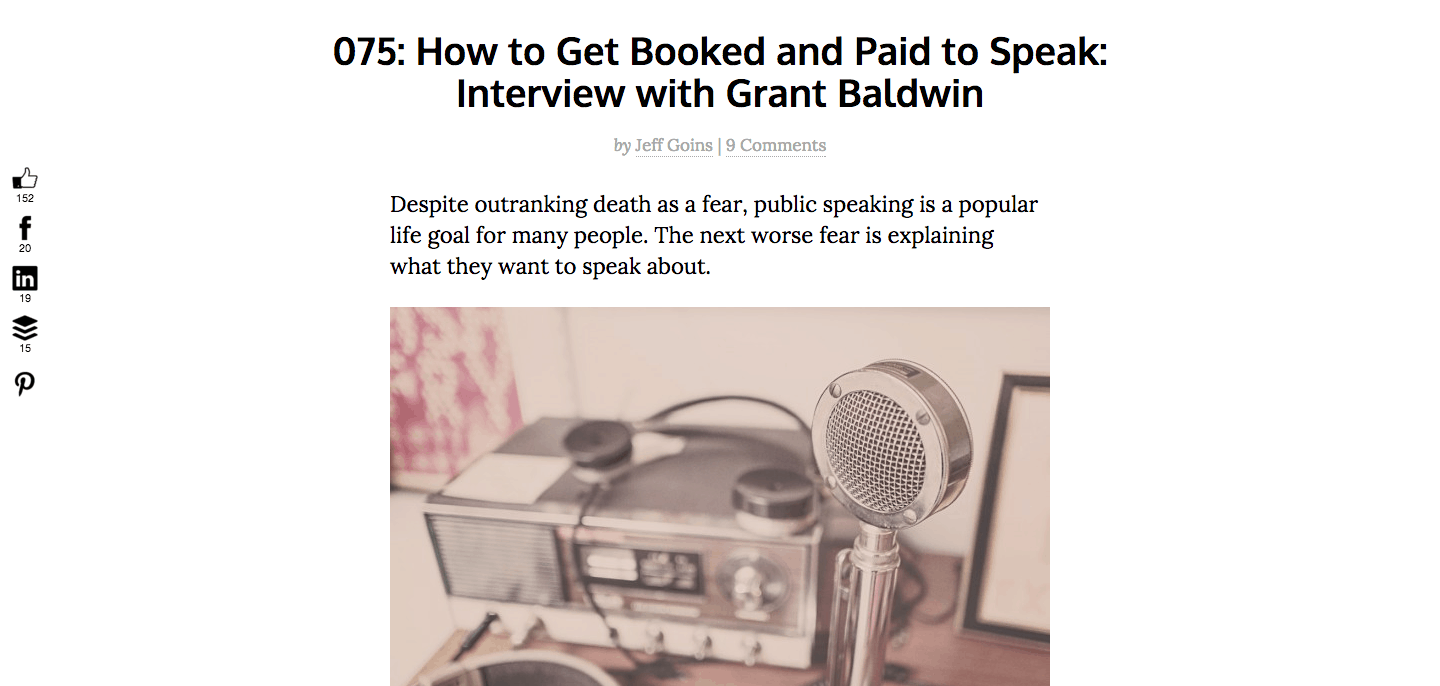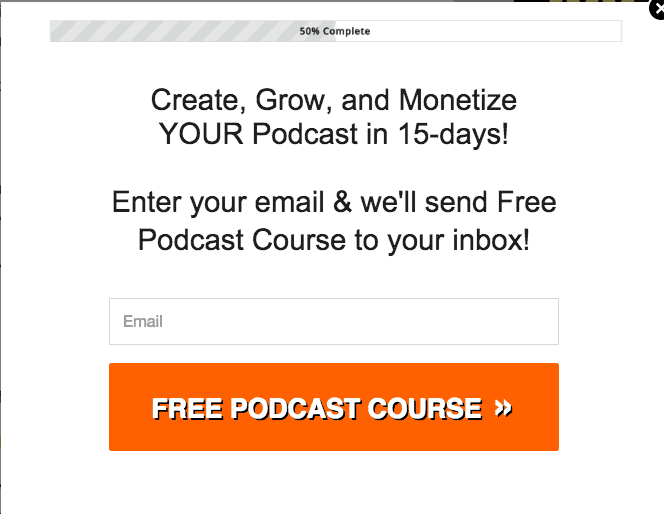Do you ever feel like you’re on a treadmill?
A “content creation” hamster wheel? It probably feels like as soon as you’ve created one piece of solid content, you have to move right on to the next one.
If you feel this way, you’re not alone.
Creating epic content that will be useful to your audience means hours of hard work between planning, research, and creativity, and you can hardly keep up. But what if I told you it doesn’t have to be this way?
What if I told you that you could do the content creation piece once…and then make it work 12 times as hard for you?
No, I’m not talking about plagiarizing yourself. I’m not going to give you the next quick-fix scheme or tell you to repost all of your articles or podcast episodes to Medium or another publishing platform.
I’m talking about repurposing your content.
How to Make One Piece of Content Work 12x as Hard
If you think about it, working hard on one piece of content and then moving right to the next is sort of like receiving a windfall and storing it in your checking account.
Sure, your checking account does the job. It might earn a few pennies of interest—just like your content might earn some likes, views, and shares—but it’s only earning you a fraction of the amount it could.
Instead of putting your content in your digital checking account to earn a meager return, make a smart investment.
How do you invest your content so it pays dividends?
By repurposing it.
Repurposing your content—that content you spent hours creating—not only saves you a ton of time, but also helps you get it in front of more eyes on more channels, catering to a variety of readers. I’m talking about distributing your work in a new, fresh way to provide value to even more people than its original form ever will.
Here are 12 ways you can repurpose your content:
Iterate in Audio
Spread the Word in Interviews
Inform with Infographics
Build Your List with Content Upgrades
Spread the Love with SlideShare
Share Bite-Sized Chunks on Social Media
Teach with Webinars
Create Valuable Courses
Break It Down Into an Email Series
Bring it Together with an eBook
Challenge Your Audience
Connect with Video
Iterate in Audio
There are some limitations to written content.
For example, readers have quickly scanned over articles for years, and they still do, especially with the abundance of information available online to absorb. At best, they get the CliffsNotes version of your written content, because they’re not reading every word.
Another limitation is that a reader has to maintain singular focus with written content. Your audience can’t read your article and drive at the same time, for example.
But audio picks up some of this slack. With audio, your audience can clean the house and listen to your content from start to finish. They can let your voice impart wisdom during a tough run or teach them something new as they get ready in the morning.
These magic multi-tasking powers make audio the perfect way to repurpose your written content.
If you have an article you can record as an audio blog or a podcast episode, whip it into an audio file, like Corbett Barr from Fizzle.co did with an article written on Fizzle’s blog, The Sparkline:
He then used this article as the basis of an episode for his podcast, Lifestyle Business Weekly.
Spread the Word in Interviews
Most people create a piece of content and then it goes out to their audience, which consumes it and benefits from it. Unfortunately, aside from sharing on social, the content usually doesn’t reach too far past their own audience.
There are thousands of other people who would find value in the content…if only there was a way to reach them.
Oh wait! There is:
Interviews.
Specifically, being interviewed by an influencer. This is a version of the age-old PR move, doing a promotional interview for a new book or movie. In this case, you’re spreading the word about a topic you’ve previously written about, relayed directly to a fresh audience by someone they trust.
An example of somebody who does this particularly well is Grant Baldwin from the How Did You Get Into That? podcast.
Grant teaches a course called Booked and Paid to Speak, and he has repurposed some of the content from the course and other resources he’s created into interviews, like his interview with author Jeff Goins:
Repurposing your content on an interview on another publisher’s platform can help you reach a broader audience, helping your work get the attention it deserves.
Inform with Infographics
There’s no doubt visual content is appealing to us. Some estimate that content with visual elements see up to 94% more views than those without visual elements.
This is why infographics are a common way to repurpose data-packed content. Organize content into a visually appealing infographic like Neil Patel from Quicksprout did below:
You can use popular programs like Canva to create an infographic quickly.
Build Your List with Content Upgrades
An up-and-coming list-building tactic in online marketing is content upgrades.
A content upgrade is anything you give away as a freebie that adds to the piece of content in some way, in exchange for an email address. They take many forms, such as a checklist, printable guide, swipe file, report, or video series.
Content upgrades create a higher perceived value for your content and also jump start your conversions, in some cases up to 216%.
For example, Brian Dean from the Search Engine Optimization blog Backlinko re-purposed the foundation of his article into a checklist:
Bonus points to Brian for repurposing not only into a content upgrade but also into an infographic.
Spread the Love with SlideShare
One channel chock-full of untapped potential for repurposing content into nuggets of visual wisdom is SlideShare.
Slideshare is completely underappreciated in the content marketing space, which is a shame, since its 70 million users make it one of the top 100 most visited websites in the world.
How can you use SlideShare to repurpose that content? Glad you asked.
Let’s say you labored over a detailed guide packed full of valuable content to post to your blog.
Instead of just posting and forgetting it, break the post up into bite-sized pieces and create a slide deck using a tool like Canva. Post to SlideShare to reach a whole new audience with the information.
Donna Moritz from Socially Sorted often repurposes her content in this way. For example, she posted an article on her blog called “21 Pro Tips for a Packed House at Your Webinar or Live Event using Visual Marketing.”
She then took the content that she worked so hard to create and flipped it into a SlideShare presentation, which has been viewed more than 9,500 times:
Can you do the same with an article on your blog?
Share Bite-Sized Chunks on Social Media
One of the easiest ways to get started in repurposing your content is on social media, because you can share in small, easily digestible pieces.
Repurposing your content on social media also takes far less time and energy that other platforms, because the messages are usually shorter and more visual. You can start by sharing one tip or motivating message.
Shawn Stevenson from The Model Health Show podcast re-purposes some of the content in his episodes on social media, like in one of his recent Instagrams:
Whether you choose Instagram, Twitter, Facebook, Periscope, Pinterest, Vine or Snapchat, you can get started now.
Teach with Webinars
You’ve probably heard that webinars are amazing list-building tools and wanted in on the fun for some time. The problem is, you have no idea what you would teach, so you haven’t taken action yet.
Why not look to the content you’ve already created?
Chalene Johnson has published written and video content on the topic of confidence:
Which she then teaches in a webinar:
It’s undeniable that webinars not only provide a ton of value to your audience but also supercharge your list building. So why not use the content you’ve already created and repurpose it in this unique way?
Create Valuable Courses
Smart entrepreneurs often have significant expertise on a subject, or will do exhaustive research related to a topic to deliver something valuable to our audiences. But the resulting content we post to a blog might only scratch the surface. This is a prime opportunity to use that piece of content as a framework for more elaborate courses.
Foundr did this with a hit article from the Foundr Blog about gaining more Instagram followers:
The post was a hit, so Foundr re-purposed it into a free eBook:
There is so much to teach and say about something like dominating Instagram, but only so much room in a content calendar, so Foundr took the framework of the eBook and article and created an entire video course called Instagram Domination (which helps you make your Instagram account become a growth machine for your business):
The popularity of the article proved that the topic was a hit with the Foundr audience. Foundr then was able to repurpose the content, amping it up to give them more of what they wanted.
Break It Down Into an Email Series
Have you ever tried to learn something from a book or a guide and become overwhelmed?
It feels as if everything is coming at you all at once, and it’s hard to digest. You wish it could just be broken down into bite sized chunks. Right? If you have a popular article, podcast episode, or ebook, chances are some of your audience feels the same way.
Enter the email series.
Setting up an email series in the form of a free mini-training can be a powerful way to re-purpose your content while providing a high level of value to your audience at the same time.
John Lee Dumas has done this with his guides to help his readers start a podcast:
He’s repurposed that information into bite-sized chunks in his free 15-day email series:
He eventually created a full course out of the series. An email series is a great way to walk your audience through a complicated topic, and it provides an accessible entry point for readers who may shy away from one long guide.
Bring it Together with an E-book
This approach flips the previous tip on its head, converting existing content into one, longer piece that a reader can really dig into. Have you ever worked on a series of emails, articles, or even enough social content so in depth you could fill an entire e-book with all the work you’ve done?
If you have a series of written content around a central theme, publishing it to either a free or paid e-book can be a great way to repurpose that content.
For example, Darren Rowse of ProBlogger had a series of blog posts about fixing common problems with your blog. He packaged the content up into an e-book he now sells on his website:
This is helpful both for his audience, most of whom would rather not have to piece together a sequence of posts by digging through the archives, and great for Darren as he gets the content he worked so hard to create in front of more eyes.
Challenge Your Audience
One of the best ways to get your audience engaged, provide massive value, and boost your conversions is to run a free challenge.
Short challenges that last fewer than 30 days and lead a participant through a change or transformation are fun to be a part of, and they work like gangbusters for your brand.
You don’t have to recreate the wheel with your challenge, though. Repurpose some of the previous content you’ve published to make up the content of the challenge.
Jen and Jadah, the duo behind the popular smoothie website Simple Green Smoothies, have mastered this repurposing method with their 30 Day Green Smoothie Challenge.
They use many of the recipes they’ve already published in their blog to make up some of the days in the challenge, and encourage their followers to drink one green smoothie per day for a month.
What content can you repurpose into a challenge for your audience?
Connect with Video
There are a lot of different types of content out there, but you would be hard-pressed to find a better channel through which to connect with your audience than video.
Video fosters a special connection, because unlike many other channels, your followers can actually watch you in action and get a better sense of your personality.
This makes video a great way to repurpose your content. After you create an article, SlideShare, podcast episode, or any other type of content, create a video out of it.
One person who does this well is Kristina Carrillo-Bucaram from the popular raw food website FullyRaw.com.
In this example, Kristina posted a recipe for Lavender Cheesecake in the recipes section of her blog:
And she then created a YouTube video to repurpose that recipe and demonstrate how the cheesecake is made:
This allows her to reach not only the people who prefer to learn how to make recipes through video, but also those who would rather just read the recipe in text form, making this the perfect repurposing storm.
Stop Doing More Work Than You Have To
If you inherited thousands of dollars from a windfall, would you invest it to make it work for you, or leave it in your checking account to rot and succumb to the demands of inflation?
Treat your content like an investment. You poured your time, energy, and often money into creating it. Make it pay dividends for you.
So dust off that content you worked so hard to create, and whip it into repurposing shape.
Choose one platform to start with. Polish your content to fit in with that medium, and test the waters.
Then, report back. What platform did you choose? What were your results?



































